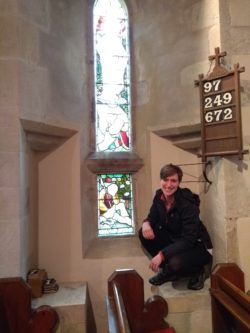Investigating Anchorites in Shropshire
Victoria Yuskaitis, one of our PhD students, visited a series of medieval Shropshire churches on a research trip to investigate the archaeological evidence for anchorites. She had this to say about her experience.
I went on a research trip to Shropshire from 19-22 April, to investigate eight area churches for archaeological remains of anchorite cells. My PhD research focuses on anchorites, medieval religious recluses who lived in small cells attached to churches, and only had contact with the outside world through small windows. One window, often called a squint by modern researchers, was used to see the Eucharist being performed: a major aspect of an anchorite’s vocation, and necessary to his/her contemplations of God.

PhD student, Victoria Yuskaitis, visited a series of medieval churches in Shropshire.
This squint is often the only surviving trace of a cell, although other surviving features include wall foundations, postholes, graves, and the cell itself. I found everything from a still-standing small cell – now used as a vestry – to a squint located within a deep-set and splayed recess. I found trace mentions of what sounded like potential anchoritic archaeology in antiquarian sources, and tracked down these mentions at the following churches: Much Wenlock Parish Church, St Martin’s (Oswestry), The Blessed Virgin Mary (Ellesmere), St John the Baptist (Ruyton-XI-Towns), St Andrew’s (Great Ness), St Andrew’s (Stanton-Upon-Hine-Heath), St John the Baptist (Church Preen), and St Mary’s (Acton Burnell).
Exciting parts of the trip include accidentally being locked inside a church (I was quietly sketching and was forgotten), and trying to find rather rural churches with spotty Google Maps coverage. This is my second trip to the area, and I spent lots of time examining all the features related to the squints I discovered, in an effort to understand when various features were inserted or built, so that I could date my discoveries. This archaeological research is essential to my larger project, which will be pulling together the evidence from archaeological, historical, and literary research to create a cohesive view of the anchoritic vocation.
